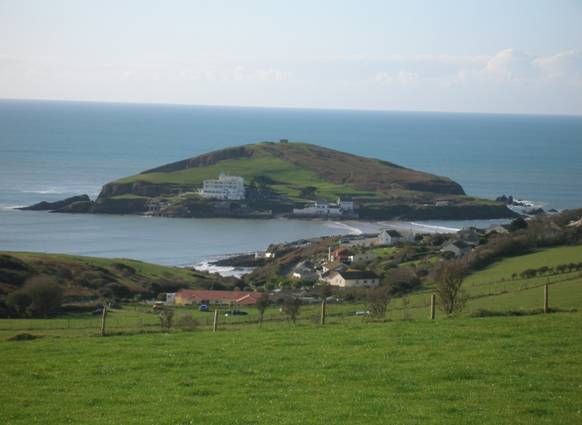Extract ElevenThe terrestrial Michael Line is not a road, nor is the maritime one a sea-lane.
They are sets of navigation markers, the pre-historical (that is the pre-literate) version of maps or, if it is preferred, of roadsigns. It is the traveller's task to decide how to get from one marker to the next, when to leave the marked passage, when to decide his destination is reached. No traveller is going to advance all the way to Land’s End because there is nothing there [1]; no traveller is going to climb to the top of Glastonbury Tor because, again, there is nothing there [2].
It is just the same with the maritime Michael Line: nobody is going to follow the Great Circle across the southwest corner of Guernsey, they will simply sail around and pick up the Great Circle on the other side (which is why, as we shall shortly see, there is a marker to that effect).
But there is a handy difference between these prehistoric landmarks and roadsigns. A road sign can be tiny because it is beside the road but a landmark has to be big enough to be seen from a distance, which is convenient for later researchers trying to reconstruct the system. Big in this context means literally ‘megalithic’ (
mega = big,
lithic = stone) and megalithic things tend to remain
in situ.
But that very longevity also creates a problem. Anything that lasts a long time in the British countryside tends to become literally a part of the British countryside and both geologists and historians have a bias towards assuming things are natural when they are not. The former have a professional reason to treat things as natural because that makes them part of the geologists’ remit; the latter have a tendency to assume things are natural because they take a highly restricted view of the capabilities of pre-historic people generally.
There is no doubt that each disputed ‘megalithic structure’ can plausibly be dismissed as ‘natural’ and its apparently significant postioning to be ‘coincidental’ (or the result of overzealous selectivity) but by the same token, should a pattern be established, it becomes increasingly difficult to defend this postion. A one-off peculiar natural formation is acceptable but two ... three ... the argument rapidly becomes indefensible.
If the pattern is established. A good current example of the way orthodoxy deals with the problem is the Cheesewring.

The view of both geologists and historians is summed up in the Wiki entry, always an excellent guide when professional opinion is for all practical purposes unanimous:
The Cheesewring is a granite tor in Cornwall, United Kingdom, situated on the eastern flank of Bodmin Moor It is a natural geological formation, a rock outcrop of granite slabs formed by weathering. The name derives from the resemblance of the piled slabs to a "cheesewring", a press-like device that was once used to make cheese.
(1) Unless you are a modern sightseer, though there is evidence that the Ancients were sightseers too.
[2] Unless you are a modern New Ager, though there is evidence that Old Agers were New Agers too.






